Law > EXAM > General Principles of Criminal Law (CRW2601) Exam 2020, Questions and Answers. General Principles of (All)
General Principles of Criminal Law (CRW2601) Exam 2020, Questions and Answers. General Principles of Criminal Law (University of South Africa)
Document Content and Description Below
General Principles of Criminal Law (CRW2601) Exam 2020, Questions and Answers General Principles of Criminal Law (University of South Africa) Multiple Choice Q’s: ANSWERS LISTED AT END OF QUESTI... ONS Question 1 (a) According to the absolute theory, punishment is an end in itself, while according to the relative theories, punishment is a means to a secondary end. (b) The effectiveness of the theory of general deterrence depends only on the severity of the punishment that is imposed on an offender. (c) The “triad in Zinn” (the crime, the criminal and interests of society) enables a court to consider all the theories of punishment when imposing sentence. (1) All the statements are correct. (2) Only statement (a) is correct. (3) Only statements (a) and (c) are correct. (4) Only statement (c) is correct. (5) Only statement (b) is correct. Question 2 (a) The correct sequence of investigation into the elements of criminal liability is conduct, compliance with definitional elements, culpability and unlawfulness. (b) Crimes are directed against public interests, while delicts are directed against private interests. (c) A statutory provision will best comply with the principle of legality if it contains a criminal norm only. (1) Only statement (b) is correct. (2) Only statements (b) and (c) are correct. (3) None of the statements is correct. (4) Only statement (a) is correct. (5) Only statement (c) is correct. Question 3 (a) In concluding that the extended definition of the crime of rape should not apply retrospectively to the accused, the Constitutional Court in Masiya v DPP 2007 (2) SACR 435 (CC) respected the ius praevium rule. (b) The rules embodying the principle of legality (ius acceptum, ius praevium, ius certum and ius strictum) are applicable to both the crime and the punishment to be imposed. (c) The Constitution contains a provision which expressly sets out the ius acceptum rule. (1) All the statements are correct. (2) Only statements (a) and (b) are correct. (3) Only statement (a) is correct. (4) Only statements (b) and (c) are correct. (5) Only statement (b) is correct. Question 4 (a) Conduct is voluntary if it is willed. (b) Relative force excludes X’s ability to subject his bodily movements to his will or intellect. (c) Sane automatism refers to cases in which X relies on the defence of mental illness. (1) Only statement (b) is correct. (2) Only statements (b) and (c) are correct. (3) Only statements (a) and (c) are correct. (4) None of the statements is correct. (5) Only statement (a) is correct. Question 5 (a) Antecedent liability is a qualification of the rule that bodily movements performed in a condition of automatism do not result in criminal liability. (b) There is a legal duty upon X to act positively if the legal convictions of the community require him to do so. (c) In Leeuw 1975 (1) SA 439 (O) it was held that mere inconvenience in complying with a legal duty did not constitute impossibility. (1) Only statement (b) is correct. (2) Only statements (b) and (c) are correct. (3) Only statements (a) and (b) are correct. (4) All the statements are correct. (5) Only statement (c) is correct. Question 6 (a) In formally defined crimes, the definitional elements proscribe a certain type of conduct irrespective of what the result of the conduct is. (b) An act is a conditio sine qua non for a situation if the act can be thought away without the situation disappearing at the same time. (c) In Tembani 2007 (1) SACR 355 (SCA), the court held that negligent medical treatment would not be regarded as a novus actus interveniens in a situation where X deliberately inflicted an intrinsically fatal wound. (1) Only statement (a) is correct. (2) Only statement (b) is correct. (3) All the statements are correct. (4) Only statements (b) and (c) are correct. (5) Only statements (a) and (c) are correct. Question 7 (a) Mental illness is a ground of justification which excludes the unlawfulness of conduct. (b) X can rely on private defence if he defends himself against an attack by an animal. (c) There is an irrebuttable presumption that a child who is below the age of seven lacks criminal capacity. (1) None of the statements is correct. (2) Only statements (b) and (c) are correct. (3) Only statement (c) is correct. (4) Only statements (a) and (b) are correct. (5) Only statement (a) is correct. Question 8 (a) The test for negligence is described as objective because it is not concerned with what X actually thought or knew or foresaw, but only with what a reasonable person in the same circumstances would have foreseen. (b) The mere fact that somebody has committed an error of judgment does not necessarily mean that he was negligent. (c) If X is charged with culpable homicide, but the evidence brings to light that X acted intentionally, he may still be convicted of culpable homicide provided his conduct did not measure up to the standard of the reasonable person. (1) All the statements are correct. (2) Only statements (a) and (c) are correct. (3) Only statement (a) is correct. (4) Only statement (a) and (b) are correct. (5) Only statement (b) is correct. Question 9 (a) The principle of contemporaneity means that there must have been culpability on the part of X at the very moment when the unlawful act was committed. (b) Mistake relating to the chain of causation may exclude intention provided that the actual chain of events differed materially from that envisaged by the perpetrator. (c) A good motive always excludes intention. (1) All the statements are correct. (2) Only statements (a) and (b) are correct. (3) Only statement (a) is correct. (4) Only statement (b) is correct. (5) Only statements (a) and (c) are correct. Question 10 (a) Provocation can never serve as a ground for the mitigation of punishment. (b) Strict liability is found in statutory crimes only. Question 1 (a) The retributive theory is the only theory of punishment which insists on there being a direct proportion between the extent of the harm or damage caused and the extent of the punishment. (b) In the decision of Zinn the court held that, in determining an appropriate sentence, the court must take into account only the interests of the society. (c) The efficacy of the theory of general deterrence depends only upon the severity of the punishment that might be imposed, and not upon the degree of probability that the criminal will be caught and convicted. (1) Only statement (a) is correct. (2) Only statements (b) and (c) are correct. (3) Only statements (a) and (c) are correct. (4) Only statement (b) is correct. (5) None of these statements is correct. Question 2 (a) The mere fact that an act corresponds to the definitional elements of an offence means that the act is unlawful. (b) A person may act in private defence in order to protect a third person even if there is no family or protective relationship between himself and the third person. (c) The judgement in Goliath is authority for the statement that one may kill an innocent person in a case of a relative compulsion. (1) Only statement (a) is correct. (2) Only statement (b) is correct. (3) Only statements (a) and (c) are correct. (4) Only statements (b) and (c) are correct. (5) All of these statements are correct. Question 3 (a) Putative private defence is not actual private defence and can therefore not exclude X’s culpability. (b) For X to succeed with a defence of private defence, his defensive act must have been directed at an attack that has already been completed. (c) The test to determine necessity is an objective test. (1) Only statement (a) is correct. (2) Only statement (c) is correct. (3) Only statement (b) is correct. (4) Only statements (a) and (c) are correct. (5) All these statements are correct. Question 4 (a) In Chretien 1981 (1) SA 1097 (A) the court rejected the “specific intent theory” with regard to intoxication. (b) If X is charged with murder and the court finds that he was so intoxicated that he lacked the intention at the time of the commission of the crime, he canot be convicted of any crime. (c) One of the requirements for a conviction of a contravention of section 1 of Act 1 of 1988 is that X should have lacked criminal capacity at the time of the commission of the act. (1) Only statement (b) is correct. (2) Only statement (c) is correct. (3) Only statement (a) is correct. (4) All these statements are correct. (5) Only statements (a) and (c) are correct. Question 5 (a) The cognitive component of criminal capacity is present if X has the ability to appreciate the wrongfulness of his act. (b) In Kavin 1978 (2) SA 731 (W) the defence of mental illness was reaised successfully. (c) The test for mental illness comprises both a pathological and biological test. (1) Only statement (a) is correct. (2) Only statement (c) is correct. (3) Only statements (a) and (b) are correct. (4) All these statements are correct. (5) Only statements (a) and (c) is correct. Question 6 (a) The ius certum principle, which forms part of the principle of legality, implies that nobody ought to be convicted of a crime, unless the kind of act performed by him had been recognised by the law as a crime already at the time of its commission. (b) Before one can assume that a provision in a statute had created a crime, it must be clear that the provision contains a criminal norm. (c) The ius strictum principle implies that a court is not authorised to extend an crime’s field of application by analogy to the detriment of the accused. (1) Only statement (a) is correct. (2) Only statement (c) is correct. (3) Only statements (a) and (b) are correct. (4) Only statements (b) and (c) are correct. (5) All the statements are correct. Question 7 (a) Evidence of provocation may sometimes serve to confirm the existence of intention to commit the crime with which X is charged. (b) If X is charged with assualt with intent to do grievous bodily harm and it appears from the evidence that he was provoked, the provocation may have the effect that X will not be found guilty of assault with intent to do grievous bodily harm but only of common assault. (c) In the decision of Ngubane the court held that it is wrong to assume that proof that X acted intentionally excludes the possibility of a finding that he acted negligently. (1) Only statements (a) and (b) are correct. (2) Only statements (a) and (c) are correct. (3) Only statements (b) and (c) are correct. (4) Only statement (b) is correct. (5) All these statements are correct. Question 1 (a) Conduct can only be voluntary if it is willed. (b) The general criterion to determine whether there is a legal duty on someone to act positively is the legal convictions of the community. (c) The term “conduct” as used in criminal law does not include a voluntary human omission. (1) Only statement (a) is correct. (2) Only statement (b) is correct. (3) Only statements (a) and (b) are correct. (4) None of the statements is correct. (5) Only statement (c) is correct. Question 2 (a) In order to qualify as a novus actus interveniens, an occurrence must be unexpected, abnormal, or unusual. (b) A mistake need not be reasonable or material to exclude intention. (c) In the case of formally defined crimes, the definitional elements proscribe a certain type of conduct which causes a specific condition. (1) Only statement (a) is correct. (2) Only statement (b) is correct. (3) Only statements (a) and (b) are correct. (4) Only statement (c) is correct. (5) None of these statements is correct. Question 3 (a) Antecedent liability rules out the defence of automatism. (b) The mere fact that an act corresponds to the definitional elements of a crime means that the act is unlawful. (c) One of the requirements for the existence of direct intention (dolus directus) is that X must have an evil motive to commit the relevant act or to cause the relevant result. (1) Only statement (c) is correct. (2) Only statements (b) and (c) are correct. (3) Only statements (a) and (c) are correct. (4) Only statement (b) is correct. (5) Only statement (a) is correct. Question 4 (a) As guardians of good morals (custodes morum) our courts are obliged to punish immoral and dangerous conduct. (b) According to South African law, corporate bodies cannot be convicted of crimes. (c) Because the possibility of death as a result of an assault is always reasonably foreseeable and the reasonable person would have guarded against this possibility, the person committing assault will always be convicted of culpable homicide if the victim died. (1) Only statement (c) is correct. (2) None of the statements is correct. (3) Only statements (b) and (c) are correct. (4) Only statement (b) is correct. (5) Only statement (a) is correct. Question 5 (a) In Chretien 1981 (1) SA 1097 (A) the court rejected the “specific intent theory” with regard to intoxication. (b) If X encourages the severely depressed Y to commit suicide by giving her a loaded pistol to shoot and kill herself, he can never be convicted of Y’s murder if she voluntarily takes the pistol and kills herself. (c) The “triad in Zinn” refers to the crime, the criminal, and the punishment. (1) Only statements (a) and (b) are correct. (2) Only statement (c) is correct. (3) Only statement (a) is correct. (4) Only statement (b) is correct. (5) Only statements (a) and (c) are correct. Question 6 (a) Necessity always stems from an unlawful human act. (b) The cognitive component of criminal capacity is present if X has the ability to conduct himself in accordance with his appreciation of the wrongfulness of his conduct. (c) Vicarious liability applies only to statutory crimes. (1) Only statement (a) is correct. (2) Only statement (b) is correct. (3) Only statements (a) and (c) are correct. (4) None of these statements is correct. (5) Only statement (c) is correct. Question 7 (a) An act in obedience to an unlawful order can only be justified if the order is not manifestly unlawful. (b) The reasonable person is a figment of the imagination of the bonus paterfamilias. (c) In materially defined crimes requiring negligence it must be proved that X was negligent in the causing of a result. (1) Only statement (a) is correct. (2) Only statements (a) and (b) are correct. (3) All the statements are correct. (4) Only statements (a) and (c) are correct. (5) Only statements (b) and (c) are correct. Question 8 (a) Putative private defence is a defence excluding culpability and not a defence excluding the element of unlawfulness. (b) In Mtshiza 1970 (3) SA 747 (A) the court approved the transferred intent approach in respect of cases involving aberratio ictus. (c) The test for dolus eventualis is whether a person ought to have foreseen the possibility of a consequence ensuing. (1) Only statements (a) and (b) are correct. (2) None of these statements is correct. (3) Only statement (a) is correct. (4) Only statement (b) is correct. (5) Only statements (a) and (c) are correct. Question 9 (a) The words “mental illness” in section 78(1) of the Criminal Procedure Act 51 of 1977 Question 1 (a) Conduct can only be voluntary if it is willed. (b) The general criterion to determine whether there is a legal duty on someone to act positively is the legal convictions of the community. (c) The term “conduct” as used in criminal law does not include a voluntary human omission. (1) Only statement (a) is correct. (2) Only statement (b) is correct. (3) Only statements (a) and (b) are correct. (4) None of the statements is correct. (5) Only statement (c) is correct. Question 2 (a) In order to qualify as a novus actus interveniens, an occurrence must be unexpected, abnormal, or unusual. (b) A mistake need not be reasonable or material to exclude intention. (c) In the case of formally defined crimes, the definitional elements proscribe a certain type of conduct which causes a specific condition. (1) Only statement (a) is correct. (2) Only statement (b) is correct. (3) Only statements (a) and (b) are correct. (4) Only statement (c) is correct. (5) None of these statements is correct. Question 3 (a) Antecedent liability rules out the defence of automatism. (b) The mere fact that an act corresponds to the definitional elements of a crime means that the act is unlawful. (c) One of the requirements for the existence of direct intention (dolus directus) is that X must have an evil motive to commit the relevant act or to cause the relevant result. (1) Only statement (c) is correct. (2) Only statements (b) and (c) are correct. (3) Only statements (a) and (c) are correct. (4) Only statement (b) is correct. (5) Only statement (a) is correct. Question 4 (a) As guardians of good morals (custodes morum) our courts are obliged to punish immoral and dangerous conduct. (b) According to South African law, corporate bodies cannot be convicted of crimes. (c) Because the possibility of death as a result of an assault is always reasonably foreseeable and the reasonable person would have guarded against this possibility, the person committing assault will always be convicted of culpable homicide if the victim died. (1) Only statement (c) is correct. (2) None of the statements is correct. (3) Only statements (b) and (c) are correct. (4) Only statement (b) is correct. (5) Only statement (a) is correct. Question 5 (a) In Chretien 1981 (1) SA 1097 (A) the court rejected the “specific intent theory” with regard to intoxication. (b) If X encourages the severely depressed Y to commit suicide by giving her a loaded pistol to shoot and kill herself, he can never be convicted of Y’s murder if she voluntarily takes the pistol and kills herself. (c) The “triad in Zinn” refers to the crime, the criminal, and the punishment. (1) Only statements (a) and (b) are correct. (2) Only statement (c) is correct. (3) Only statement (a) is correct. (4) Only statement (b) is correct. (5) Only statements (a) and (c) are correct. Question 6 (a) Necessity always stems from an unlawful human act. (b) The cognitive component of criminal capacity is present if X has the ability to conduct himself in accordance with his appreciation of the wrongfulness of his conduct. (c) Vicarious liability applies only to statutory crimes. (1) Only statement (a) is correct. (2) Only statement (b) is correct. (3) Only statements (a) and (c) are correct. (4) None of these statements is correct. (5) Only statement (c) is correct. Question 7 (a) An act in obedience to an unlawful order can only be justified if the order is not manifestly unlawful. (b) The reasonable person is a figment of the imagination of the bonus paterfamilias. (c) In materially defined crimes requiring negligence it must be proved that X was negligent in the causing of a result. (1) Only statement (a) is correct. (2) Only statements (a) and (b) are correct. (3) All the statements are correct. (4) Only statements (a) and (c) are correct. (5) Only statements (b) and (c) are correct. Question 8 (a) Putative private defence is a defence excluding culpability and not a defence excluding the element of unlawfulness. (b) In Mtshiza 1970 (3) SA 747 (A) the court approved the transferred intent approach in respect of cases involving aberratio ictus. (c) The test for dolus eventualis is whether a person ought to have foreseen the possibility of a consequence ensuing. (1) Only statements (a) and (b) are correct. (2) None of these statements is correct. (3) Only statement (a) is correct. (4) Only statement (b) is correct. (5) Only statements (a) and (c) are correct. Question 9 (a) The words “mental illness” in section 78(1) of the Criminal Procedure Act 51 of 1977 refer to a pathological disturbance of the mental faculties. (b) In Eadie 2002 (1) SACR 663 (SCA) the court held that the defence of non-pathological criminal incapacity resulting from emotional stress amounts to the defence of sane automatism. (c) Children younger than 14 years are irrebuttably presumed to lack criminal capacity. (1) Only statement (a) is correct. (2) Only statement (b) is correct. (3) Only statements (a) and (b) are correct. (4) Only statements (a) and (c) are correct. (5) Only statement (c) is correct. Question 10 (a) In terms of the ius strictum principle crimes should be defined clearly and not vaguely. (b) Where doubt exists concerning the interpretation of a widely formulated criminal provision in an act, the provision should be interpreted in favour of the accused. (c) The preventive theory overlaps the deterrent and the reformative theories since all these theories aim to prevent the commission of crimes. (1) Only statement (a) is correct. (2) Only statement (b) is correct. (2) Only statement (b) is correct. (3) None of these statements is correct. (4) Only statements (a) and (b) are correct. (5) Only statements (a) and (c) are correct. Question 3 (a) Conduct is voluntary if X is capable of subjecting his bodily movements to his will or intellect. (b) Sane automatism is a defence which excludes the voluntariness of conduct. (c) There is a legal duty upon a person to act positively if the legal convictions of the community require him/her to do so. (1) Only statement (a) is correct. (2) Only statements (a) and (b) are correct. (3) None of the statements is correct. (4) Only statements (b) and (c) are correct. (5) All the statements are correct. Question 4 (a) An act which complies with the definitional elements of a crime is necessarily also unlawful. (b) The Constitution of the Republic of South Africa 108 of 1996 provides that no member of any security service may obey a manifestly unlawful order. (c) Physical harm inflicted on a person with his/her consent is never regarded by the criminal law as unlawful conduct. (1) None of the statements is correct. (2) Only statement (b) is correct. (3) Only statements (b) and (c) are correct. (4) Only statement (a) is correct. (5) Only statements (a) and (c) are correct. Question 5 (a) For a plea of necessity to succeed, it is immaterial whether the situation of emergency is the result of human action (eg coercion) or chance circumstances (eg famine or a flood). (b) Goliath 1972 (3) SA 1 (A) is authority for the statement that the killing of an innocent person in a situation of necessity may in certain circumstances constitute a complete defence. (c) According to the South African Constitution, a husband who imposes corporal punishment on his wife, may successfully rely on the ground of justification known as “the right of chastisement”. (1) Only statement (c) is correct. (2) Only statements (b) and (c) are correct. (3) None of the statements is correct. (4) All the statements are correct. (5) Only statements (a) and (b) are correct. Question 6 (a) Youth is a ground of justification which excludes the unlawfulness of conduct. (b) The term “criminal capacity” refers to the mental ability which a person must have in order to be liable for a crime. (c) The conative component of criminal capacity refers to X’s ability to appreciate the wrongfulness of his/her act or omission. (1) Only statement (c) is correct. (2) Only statement (b) is correct. (3) All the statements are correct. (4) Only statements (b) and (c) are correct. (5) Only statements (a) and (c) are correct. Question 7 (a) Mental illness is a defence which may exclude criminal capacity. (b) In Kavin 1978 (2) SA 731 (W) X’s defence that he suffered from a mental illness was accepted on the ground that he had acted on an irresistible impulse. (c) For the defence of mental illness to succeed, it must be proved that the illness is of a permanent nature. (1) Only statements (b) and (c) are correct. (2) Only statement (c) is correct. (3) Only statement (a) is correct. (4) Only statements (a) and (c) are correct. (5) All the statements are correct. Question 8 (a) If the accused relies on the defence of mental illness, the court must decide upon the issue with the aid of expert evidence given by psychiatrists. (b) The cognitive leg of the test for criminal capacity refers to persons’s ability to act in accordance with his/her insight into right or wrong. (c) The defence of mental illness is also referred to as the defence of non-pathological criminal incapacity. (1) Only statement (a) is correct. (2) Only statement (c) is correct. (3) Only statements (a) and (c) are correct. (4) Only statements (a) and (b) are correct. (5) None of the statements is correct. Question 9 (a) When determining whether the accused had intention, the question is whether he/she should have foreseen the result of his conduct. (b) The motive of the accused for committing the crime is essential in determining whether he/she had intention. (c) Mistake relating to the chain of causation may exclude intention provided that the actual chain of events differed materially from that envisaged by the perpetrator. (1) All the statements are correct. (2) Only statement (c) is correct. (3) Only statements (b) and (c) are correct. (4) Only statement (a) is correct. (5) Only statement (b) is correct. Question 10 (a) In Mtshiza 1970 (3) SA 747 (A) the court favoured the concrete culpability approach in aberratio ictus situations. (b) Provocation can never serve as a ground for the mitigation of punishment. (c) Strict liability is found in statutory crimes only. (1) Only statement (c) is correct. (2) Only statement (b) is correct. (3) Only statement (a) is correct. (4) Only statements (a) and (c) are correct. (5) All the statements are correct. Question 1 (a) A crime is ordinarily injurious to public interests (the interests of the state or the community) whereas a delict is ordinarily injurious only to private or individual interests. (b) The state prosecutes a perpetrator of crime irrespective of the desires of a complainant. (c) The forfeiture of a driver’s licence is an example of punishment which strives to prevent crime. (1) Only statement (a) is correct. (2) Only statement (b) is correct. (3) Only statements (a) and (c) are correct. (4) None of the statements is correct. (5) All the statements are correct. Question 2 (a) A criminal norm a provision in an Act which makes it clear that certain conduct constitutes a crime. (b) A provision in an Act which merely provides that “No person shall drink in a public place” creates a criminal norm. (c) A criminal sanction is a provision in an Act which stipulates what punishment a court must impose after it has convicted a person of that crime. (1) Only statement (a) is correct. (2) Only statement (c) is correct. (3) Only statements (a) and (b) are correct. (4) Only statements (a) and (c) are correct. (5) None of these statements is correct. Question 3 (a) Conduct is voluntary if X is capable of subjecting his bodily movements to his will or intellect. (b) Absolute force is a ground of justification which excludes the unlawfulness of conduct. (c) Sane automatism excludes the voluntariness of conduct. 4 (1) Only statement (a) is correct. (2) Only statements (b) and (c) are correct. (3) Only statements (a) and (c) are correct. (4) None of these statements is correct. (5) Only statement (c) is correct. Question 4 (a) “Acts” committed whilst sleepwalking or while a person is suffering from an epileptic fit, are examples of insane automatism. (b) In cases of sane automatism, the onus is on the state to prove that the act was voluntary. (c) In order to succeed with a defence of impossibility, it must be subjectively impossible for X to comply with the relevant legal provision. (1) Only statement (c) is correct. (2) None of the statements is correct. (3) Only statements (a) and (b) are correct. (4) Only statement (b) is correct. (5) Only statements (a) and (c) are correct. Question 5 (a) An act which complies with the definitional elements of an offence is necessarily unlawful. (b) The Constitution of the Republic of South Africa 108 of 1996 provides that no member of a security service may obey a manifestly unlawful order. (c) Goliath 1972 (3) SA 1 (A) is authority for the statement that the killing of an innocent person in a situation of necessity may in certain circumstances constitute a complete defence. (1) All the statements are correct. (2) None of the statements is correct. (3) Only statement (a) is correct. (4) Only statement (b) is correct. (5) Only statements (b) and (c) are correct. Question 6 (a) There is an irrebuttable presumption that a child between the ages of seven and fourteen years lacks criminal capacity. (b) Mental illness is a ground of justification which excludes the unlawfulness of conduct. (c) In Kavin 1978 (2) SA 731 (W) X’s defence that he suffered from a mental illness was accepted on the ground that he had acted on an irresistible impulse. (1) Only statement (a) is correct. (2) Only statements (a) and (b) are correct. (3) Only statements (a) and (c) are correct. (4) None of these statements is correct. (5) Only statement (c) is correct. Question 7 (a) The principle of contemporaneity means that there must have been culpability on the part of X at the very moment when the unlawful act was committed. (b) A mistake must be reasonable to exclude intention. (c) If X thinks that she is shooting person Y while she is in fact shooting person Z, her mistake about the identity of the person affords her a valid defence on a charge of murder. (1) Only statement (a) is correct. (2) Only statements (a) and (b) are correct. (3) All the statements are correct. (4) Only statements (a) and (c) are correct. (5) Only statements (b) and (c) are correct. Question 8 (a) Aberratio ictus is a form of mistake. (b) The concrete culpability approach as applied in aberratio ictus situations means that the court must determine whether X had intention to kill the actual victim. (c) The transferred culpability approach amounts to an application of the doctrine of versari in re illicita. (1) Only statement (a) is correct. (2) Only statements (b) and (c) are correct. (3) Only statement (c) is correct. (4) Only statements (a) and (b) are correct. (5) All the statements are correct. Question 9 (a) The test for negligence is described as objective because it is not concerned with what X actually thought or knew or foresaw, but only with what a reasonable person in the same circumstances would have foreseen. (b) Reasonable foreseeability means that the possibility of the particular circumstance existing, or the particular result ensuing, should be investigated and not the likelihood thereof. (c) The mere fact that somebody has committed an error of judgment does not necessarily mean that he was negligent. (1) Only statements (a) and (b) are correct. (2) Only statement (a) is correct. (3) Only statement (b) is correct. recognised by the law as a crime already at the time of its commission. (b) Before one can assume that a provision in an act had created a crime, it must be clear that the provision contains a criminal norm. (c) The ius strictum principle implies inter alia that a court is not authorised to extend a crime's field of application by means of analogy to the detriment of the accused. 1. Only statement (a) is correct. 2. Only statement (c) is correct. 3. Only statements (a) and (c) are correct. 4. Only statements (b) and (c) are correct. 5. All the statements are correct. Question 3 (a) Conduct can only be voluntary if it is intentional. (b) The decision in Goliath deals with a situation in which there was absolute force. (c) A legal duty to act positively can only arise by virtue of a statute, and not in terms of the provisions of common law. 1. Only statement (a) is correct. 2. Only statement (b) is correct. 3. Only statements (a) and (b) are correct. 4. Only statements (b) and (c) are correct. 5. All these statements are incorrect. Question 4 (a) The mere fact that an act corresponds to the definitional elements of a crime means that the act is unlawful. (b) A person may act in private defence to protect a third person even if there is no family or protective relationship between himself and the third person. (c) The principle that the law does not concern itself with trifles can exclude the unlawfulness of the act. 1. Only statement (b) is correct. 2. Only statement (c) is correct. 3. All three statements are correct. 4. Only statements (a) and (b) are correct. 5. Only statements (b) and (c) are correct. Question 5 (a) X acts out of necessity if he shoots and kills a vicious dog which is about to attack him. (b) If X acts in putative private defence his conduct is not unlawful. (c) According to our present law parents are entitled to inflict moderate and reasonable corporal punishment on their children to maintain order and discipline. 1. Only statements (a) and (c) are correct. 2. Only statement (b) is correct. 3. Only statements (a) and (b) are correct. 4. Only statement (c) is correct. 5. All three statements are correct. Question 6 (a) Criminal capacity relates to a person's mental abilities, whereas culpability relates to the presence or absence of a blameworthy state of mind. (b) In the decision of Kavin the accused's defence that he lacked criminal capacity as a result of mental illness was rejected by the court on the ground that he acted slowly and deliberately rather than on an irresistible impulse. (c) The conative element of criminal capacity deals with X's self-control and is present if X has the ability to conduct himself in accordance with his appreciation of the wrongfulness of his act. 1. Only statement (a) is correct. 2. Only statements (a) and (c) are correct. 3. All these statements are correct. 4. Not one of these statements is correct. 5. Only statement (c) is correct. Question 7 (a) The cognitive component of intention means that X must have knowledge of the act, the circumstances set out in the definitional elements and the culpability requirement. (b) In order to prove that X acted with dolus eventualis, it is sufficient for the prosecution to prove that X ought to have foreseen the possibility of the forbidden consequence ensuing. (c) One of the requirements for the existence of direct intention (dolus directus) is that X must have the motive to commit the relevant act or to cause the relevant result. 1. Only statement (a) is correct. 2. Only statement (b) is correct. 3. Only statements (a) and (b) are correct. 4. Not one of the statements is correct. 5. Only statement (c) is correct. Question 8 (a) Evidence of provocation may sometimes serve to confirm the existence of intention to commit the crime with which X is charged. (b) If X is charged with assault to do grievous bodily harm and it appears from the evidence that he was provoked, the provocation may have the effect that X will not be found guilty of assault with intent to do grievous bodily harm but of common assault only. (c) In the decision of Ngubane the court held that it is wrong to assume that proof that X acted intentionally excludes the possibility of a finding that he acted negligently. 1. Only statements (a) and (b) are correct. 2. Only statements (a) and (c) are correct. 3. Only statements (b) and (c) are correct. 4. Only statement (b) is correct. 5. All three statements are correct. Question 9 (a) Vicarious liability is not limited to statutory crimes, but may be found also in common-law crimes. (b) Involuntarily intoxication may afford an accused a complete defence. (c) One of the findings of the court in the decision of Chretien was that the specific intent theory in connection with intoxication must be rejected. 1. Only statement (a) is correct. 2. Only statement (b) is correct. 3. Only statement (c) is correct. 4. Only statements (a) and (b) are correct. 5. Only statements (b) and (c) are correct. Question 10 (a) Because culpability is required for all common-law crimes, strict liability is found in statutory crimes only. (b) In South Africa corporate bodies (for instance, companies) cannot be convicted of crimes. (c) If the legislature, in creating an offence, is silent on the question whether culpability is a requirement for the offence, a court is still free to interpret the provision creating the offence in such a way that culpability is indeed required for a conviction. 1. Only statement (a) is correct. 2. Only statements (a) and (c) are correct. 3. All three statements are correct. 4. Not one of these statements is correct. 5. Only statement (c) is correct. Unit 1 - Intro 1. . Unit 2 - Principle of Legality Unit 3 - The Act (ii) . Unit 4 – The definitional elements and causation Question 2 Unit 5 - Unlawfulness Unit 6 – Unlawfulness 1 . Unit 7 Culpability & Criminal Capacity Unit 8 – Criminal capacity – Mental illness and Youth Discuss the effect of youthful age on criminal liability. (6) . Question 5 X recently gave birth. She is still in hospital. One night she gets up from her bed, walks to the ward where the babies are kept, and strangles her baby. Discuss whether X can be convicted of murder or any other crime if the evidence reveals the following: X suffers from schizophrenia, a well-known disease of the mind, and was labouring under hallucinations when she killed her baby. She was seeing monsters and hearing a voice instructing her to destroy the "monster" lying in the cradle. Question 6 Which rules should be applied to determine whether or not a youth has criminal capacity? (1) . Unit 10 – Intention – Mistake (c) Briefly explain the meaning and legal effect of the following: (1) an error in objecto which is material (2) mistake relating to a ground of justification (8) Unit 11 - Negligence The required form of culpability for the crime of culpable homicide is negligence. Define the test for negligence in materially defined crimes such as culpable homicide. Unit 12 – The effect of intoxication on liability murder Y. X and Z rely on the defence of intoxication. Discuss whether X and Z ought to succeed with this defence. (Study this one) Answer Answer (a) X attends a party hosted by his friend, Y. X consumes more liquor than usual. X is fairly intoxicated when he decides to go home. He takes a leather jacket hanging on the hall stand which he thinks belongs to him. The leather jacket in fact belongs to Z and not to X. X is charged with theft of the jacket. At the trial the court finds that, although X was intoxicated at the time he removed the jacket, he did have criminal capacity. However, the court finds that X cannot be convicted of theft, because, as a result of his intoxication, he was under the impression that the leather jacket belonged to him and therefore did not have the intention to steal the jacket. Discuss whether X may nevertheless be found guilty of a contravention of the statutory crime created in section 1 of Act 1 of 1988, that is the offence sometimes referred to as “statutory intoxication”. In your answer you must briefly state what the provisions of this section are. Question 8 X and his entire family go boating at the local dam. X drinks one beer after the other and decides to race around the dam in his ski-boat. X steers the boat. As he is intoxicated, X fails to keep a proper look-out and runs over Y, who is swimming in the dam. Y succumbs, owing to blood loss from a wound to his head made by the propeller of X’s boat. The court finds that although X was not so intoxicated that he lacked criminal capacity, he was so intoxicated that he could not have had the intention to cause Y's death. Can X be convicted of contravention of section 1 of Act 1 of 1988 and/or culpable homicide? Unit 13 – The effect of provocation on liability Unit 14 – Disregard of the requirement of culpability Discuss the criminal liability of corporate bodies. (7) Question 10 X is the housemaster of a university hostel. According to the university rules, no student may be subjected to any form of initiation. At the hostel where X is the housemaster, there is a tradition that first-year students are initiated by being subjected to all kinds of initiation activities. Students are, for instance, compelled to dive into a swimming pool while being blindfolded. X does not take part in these practices but condones them and actually watches while the senior students push the blindfolded first-year students into the swimming pool. One day, during such an initiation ceremony, a first-year student, Y, dives into the swimming pool and hits the bottom, breaking his neck, and dies. Discuss whether both X and the university (a legal person) may be convicted of culpable homicide. Fill In Questions Question 3 To be inserted in the correct units (a) On the basis of this evidence and with reference to appropriate case law, consider X’s criminal liability on a charge of culpable homicide. (3) Answer (b) X’s criminal liability on a charge of contravention of section 1 of Act 1 of 1988. (7) Answer Terms (d) Merely explain the meaning of the following terms: (i) lucidum intervallum (ii) delirium tremens (2) [Show More]
Last updated: 1 year ago
Preview 1 out of 64 pages
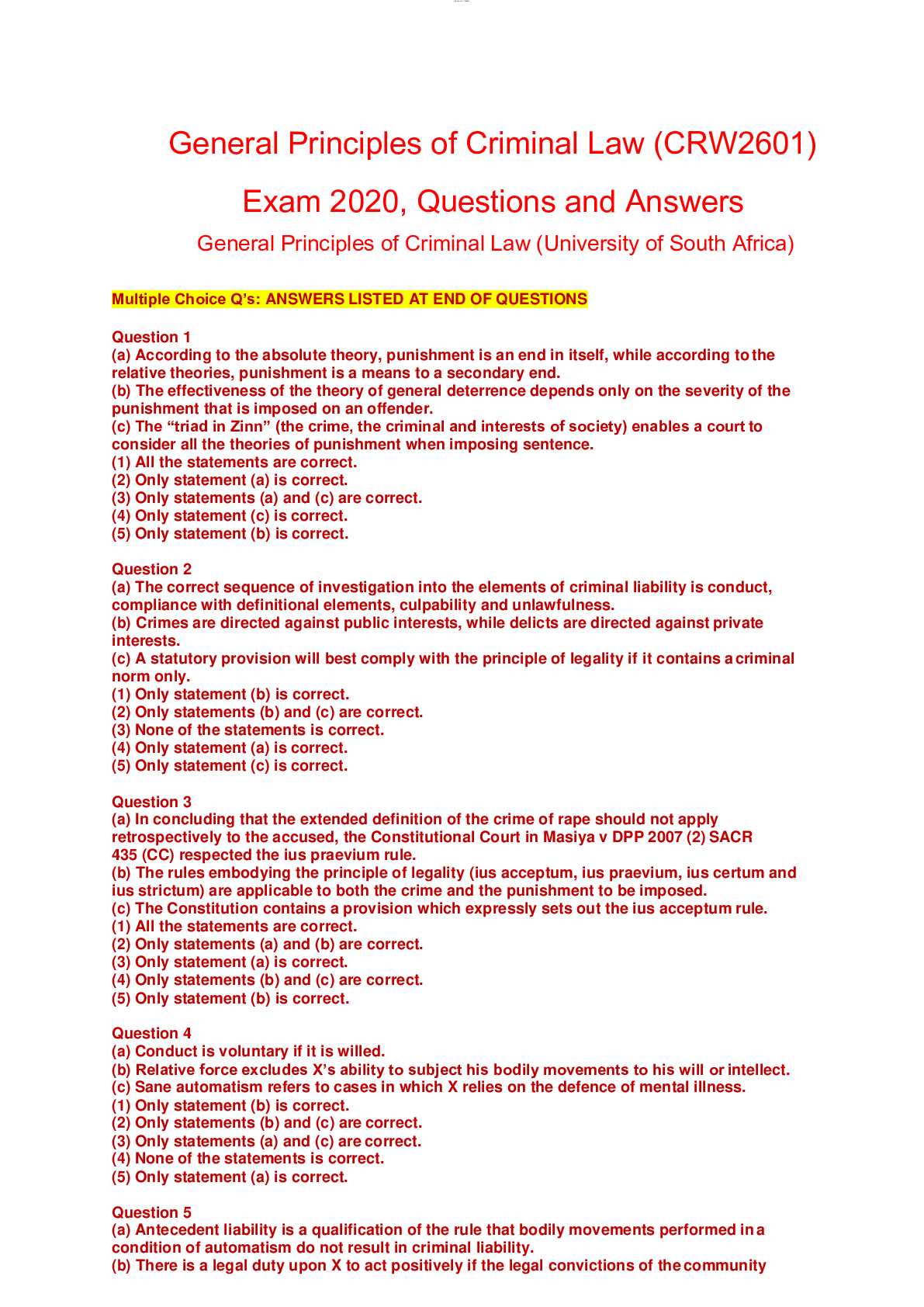
Reviews( 0 )
Recommended For You
*NURSING> EXAM > NGR 6172 Pharm Midterm Exam- Questions and Answers. Score 98% (All)
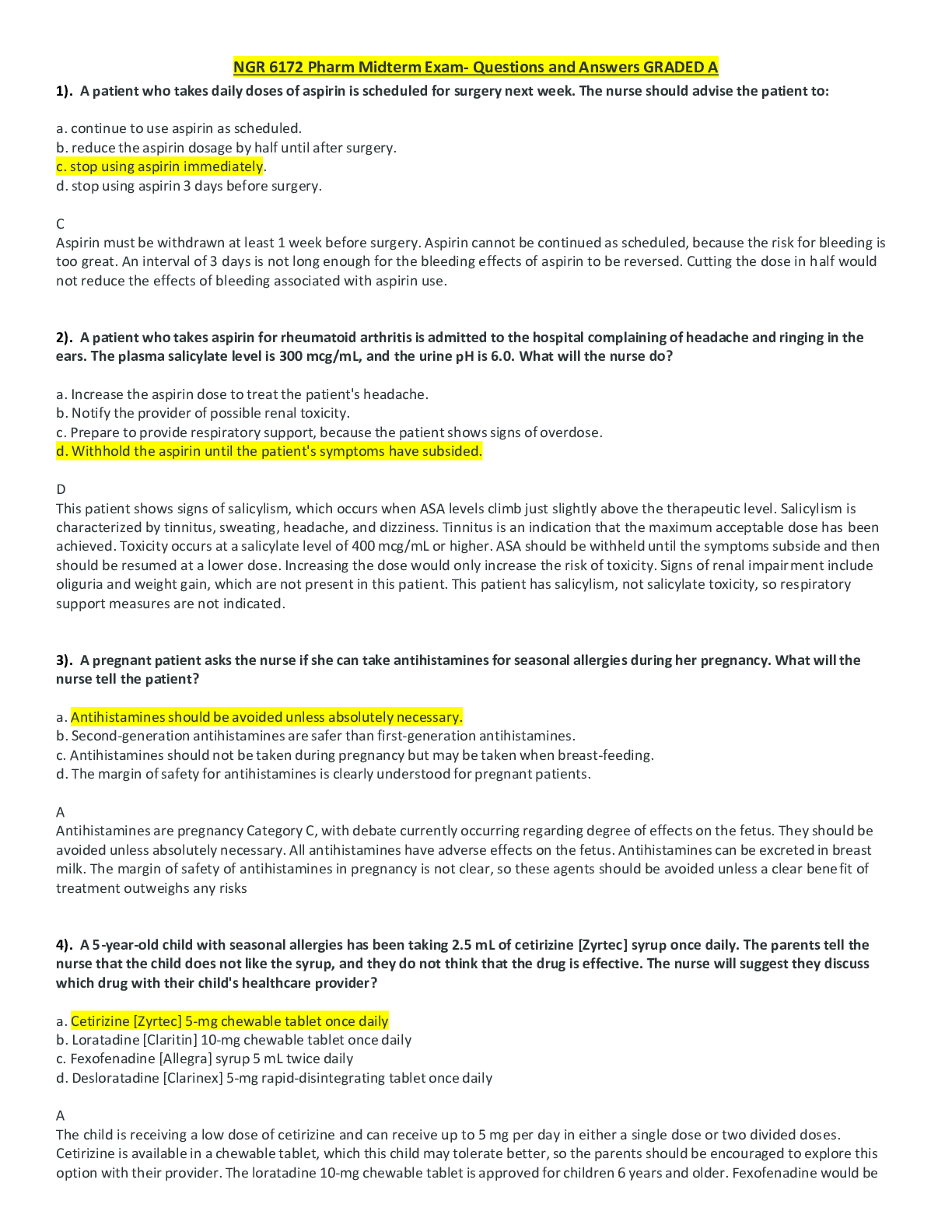
NGR 6172 Pharm Midterm Exam- Questions and Answers. Score 98%
NGR 6172 Pharm Midterm Exam- Questions and Answers GRADED A-1). A patient who takes daily doses of aspirin is scheduled for surgery next week. The nurse should advise the patient to: a. continue to...
By PROF , Uploaded: Feb 01, 2022
$11
Food and Nutrition> EXAM > ServSafe Manager Exam. COMPLETE SOLUTION with 80 Questions And Answers. (All)
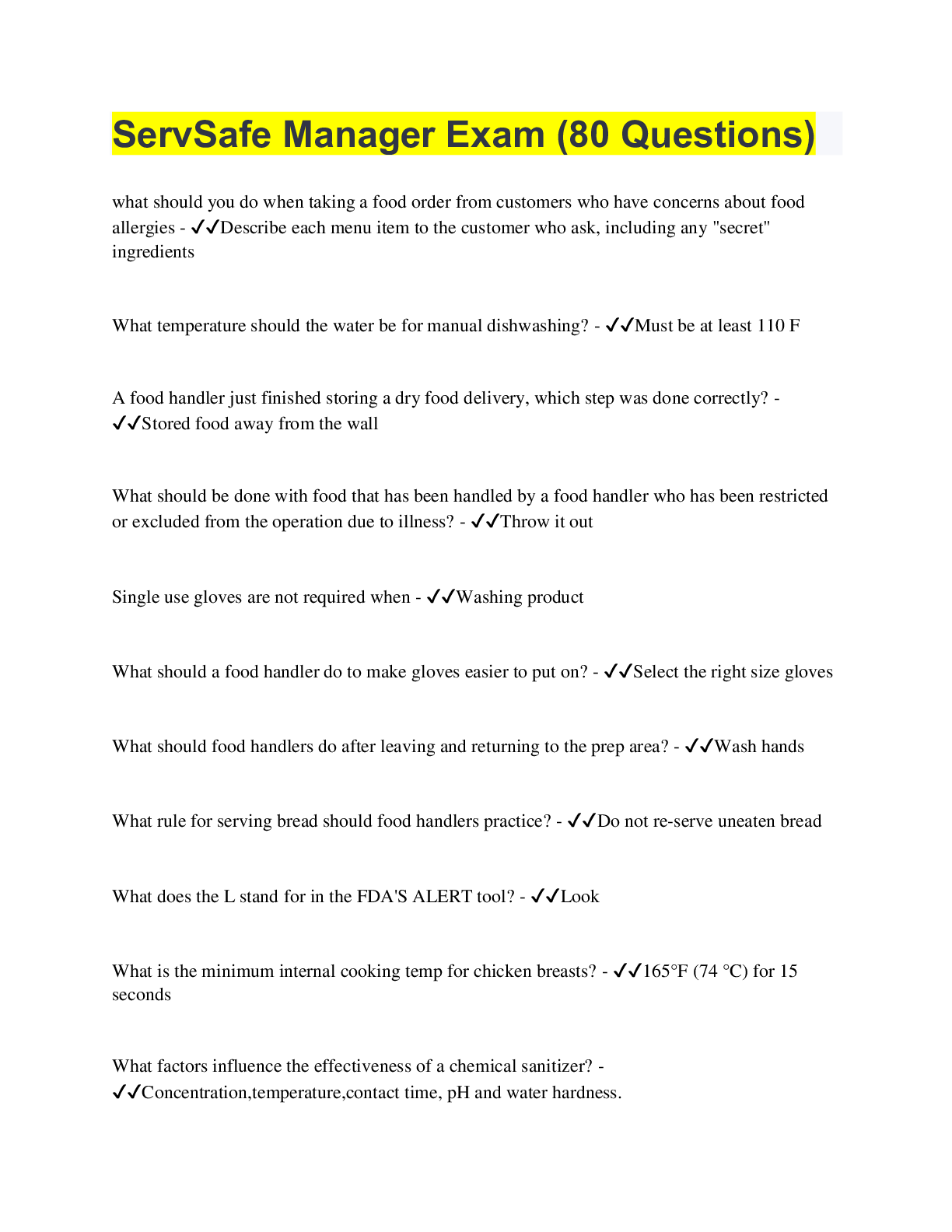
ServSafe Manager Exam. COMPLETE SOLUTION with 80 Questions And Answers.
what should you do when taking a food order from customers who have concerns about food allergies - ✔✔Describe each menu item to the customer who ask, including any "secret" ingredients What temper...
By Tessa , Uploaded: Jun 24, 2022
$11
Trauma Nurse Core Course (TNCC)> EXAM > TNCC 8th Edition Questions and Answers. (Updated 2023) Trauma Nurse Core Course (TNCC). 52 Questions with 100% Correct Answers (All)
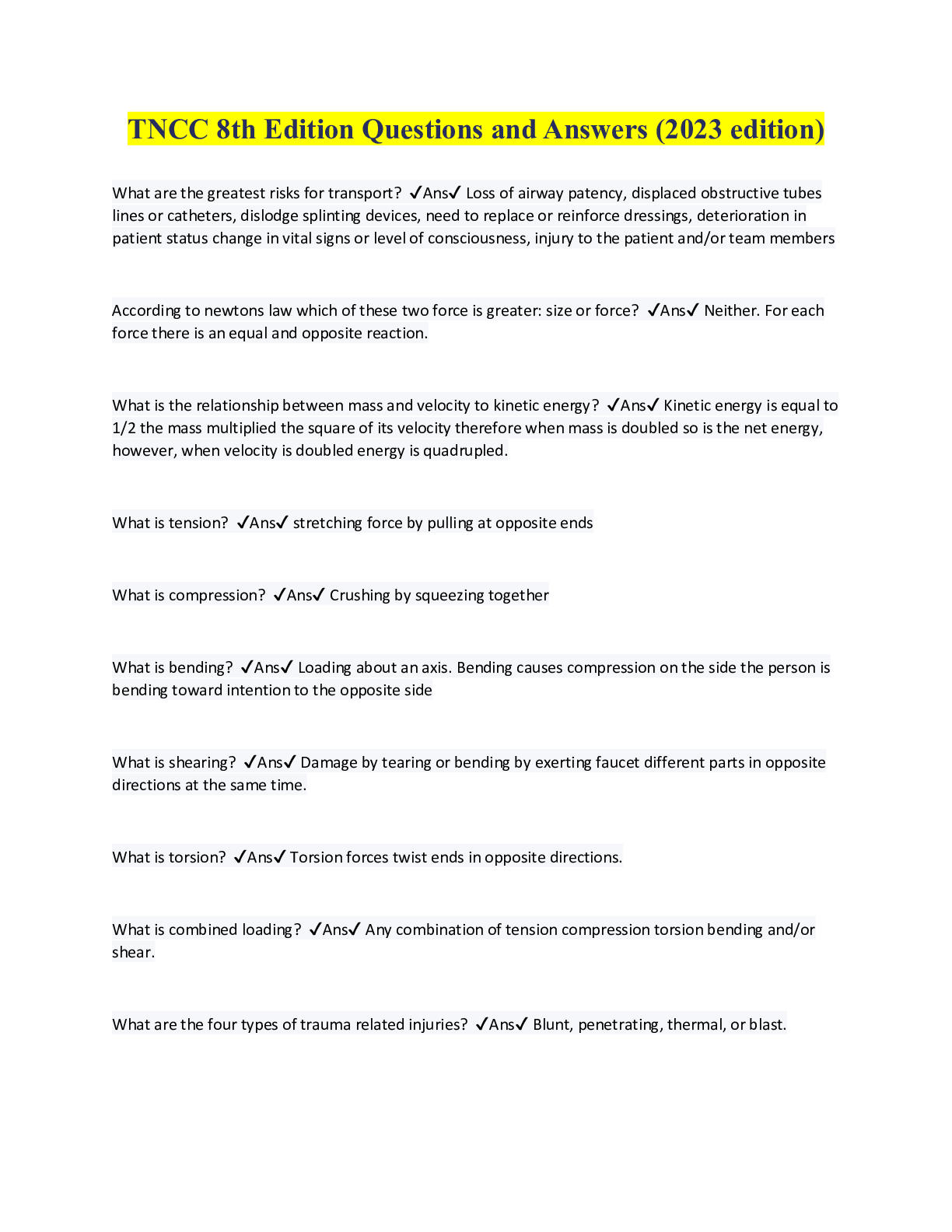
TNCC 8th Edition Questions and Answers. (Updated 2023) Trauma Nurse Core Course (TNCC). 52 Questions with 100% Correct Answers
What are the greatest risks for transport? - ✔✔Loss of airway patency, displaced obstructive tubes lines or catheters, dislodge splinting devices, need to replace or reinforce dressings, deteriorati...
By Tessa , Uploaded: May 11, 2022
$11
*NURSING> EXAM > ATI PN comprehensive predictor 2020/2021 180 Questions And Answers.(SCORE A GUARANTEED) (All)
.png)
ATI PN comprehensive predictor 2020/2021 180 Questions And Answers.(SCORE A GUARANTEED)
Ati PN comprehensive predictor 2020/2021 180 Questions And Answers.(SCORE A GUARANTEED)
By Rixx Dennis , Uploaded: Nov 17, 2021
$46
*NURSING> EXAM > APEA 3P Exam. NUR 634 Grand Canyon University. NUR-634 APEA 3P Exam Contains 150 Commonly Tested Questions and Answers. (All)
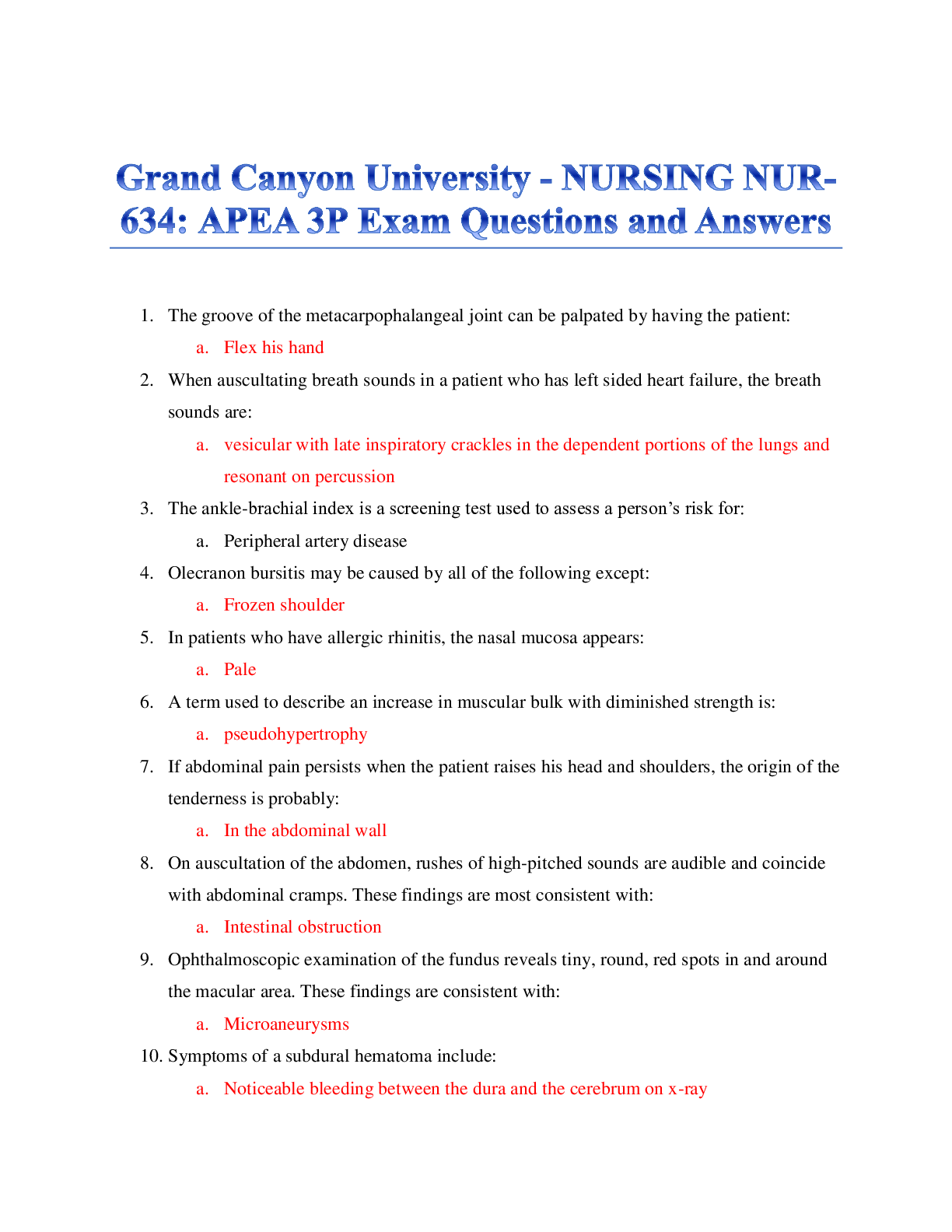
APEA 3P Exam. NUR 634 Grand Canyon University. NUR-634 APEA 3P Exam Contains 150 Commonly Tested Questions and Answers.
Grand Canyon University - NURSING NUR-634: APEA 3P Exam Questions and Answers 1. The groove of the metacarpophalangeal joint can be palpated by having the patient: 2. When auscultating breath soun...
By Kirsch , Uploaded: Mar 30, 2020
$13.5
*NURSING> EXAM > NAPSR Test. FINAL EXAM. Contains 160 Questions and Answers. (All)
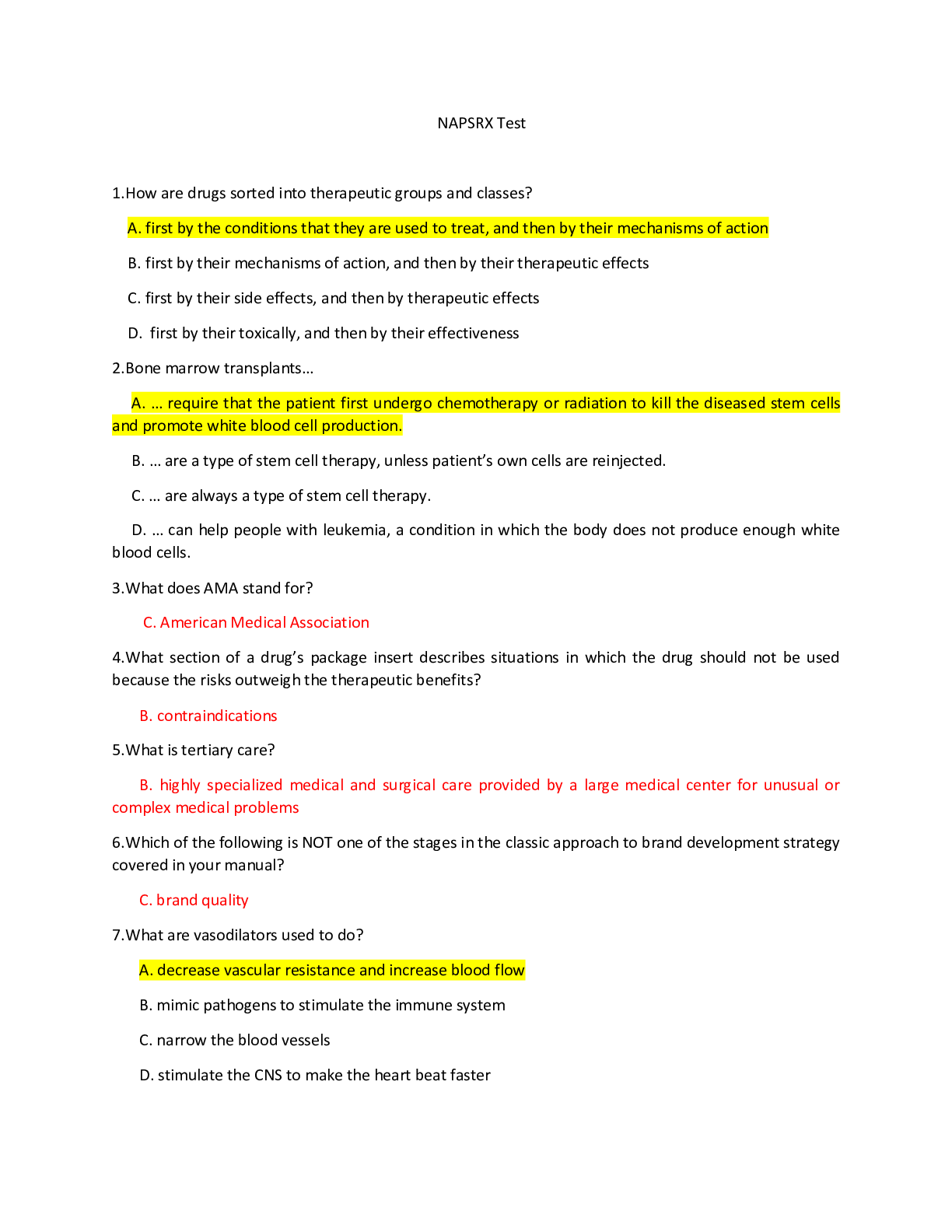
NAPSR Test. FINAL EXAM. Contains 160 Questions and Answers.
NAPSRX Test 1.How are drugs sorted into therapeutic groups and classes? A. first by the conditions that they are used to treat, and then by their mechanisms of action B. first by their me...
By James , Uploaded: Apr 13, 2020
$16
Software Engineering> EXAM > Agile Exam Questions and Answers. This Document Contains 65 Questions and Answers. (All)

Agile Exam Questions and Answers. This Document Contains 65 Questions and Answers.
TI F.P 100,23 Agile Exam Questions and Answers 1- What does NOT match with Agile Manifesto? Process and tools over individuals and interactions Working software over comprehensive documentatio...
By Kirsch , Uploaded: Dec 31, 2020
$9
*NURSING> EXAM > NURS 6521N Midterm Exam Advanced Pharmacology Walden University - 100 Questions and Answers. Score 94% (All)
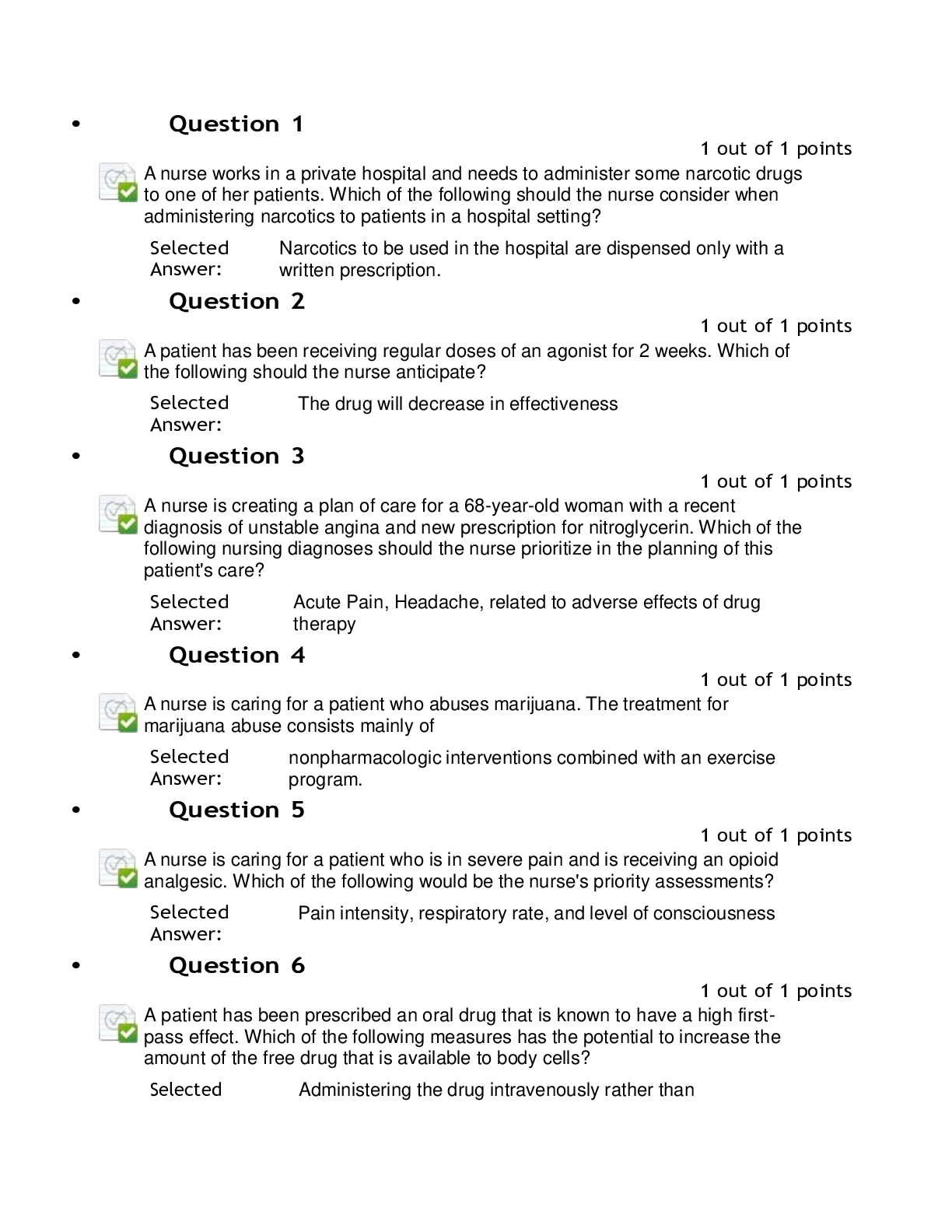
NURS 6521N Midterm Exam Advanced Pharmacology Walden University - 100 Questions and Answers. Score 94%
NURS 6521NMidterm Exam Advanced Pharmacology. 100 Questions and Answers: • Question 1 1 out of 1 points A nurse works in a private hospital and needs to administer some narcotic drugs to one...
By QuizMaster , Uploaded: Aug 14, 2020
$12
*NURSING> EXAM > NUR2868 Role and Scope Exam 3. Rasmussen College:. The most frequently tested Questions and Answers. 100%. (All)
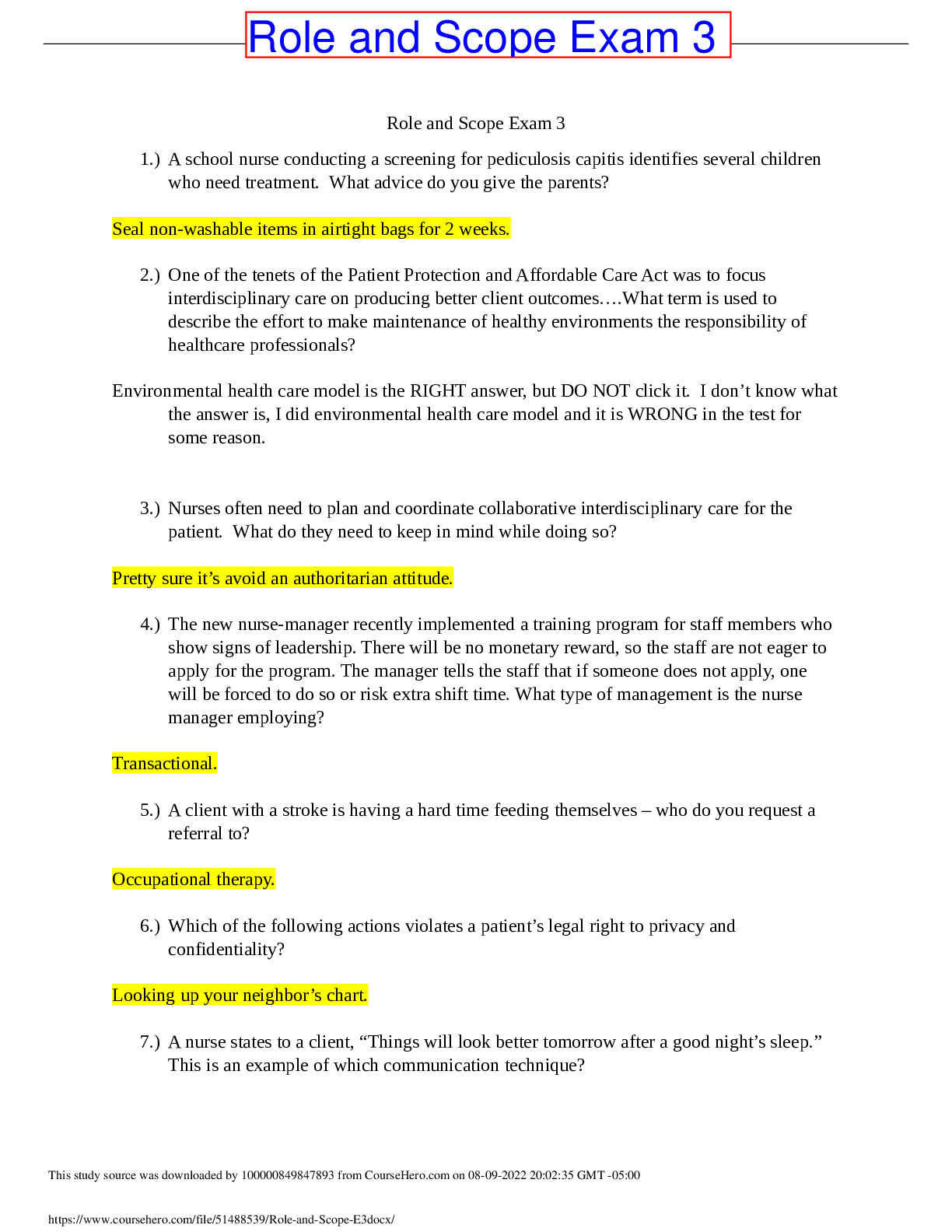
NUR2868 Role and Scope Exam 3. Rasmussen College:. The most frequently tested Questions and Answers. 100%.
Role and Scope Exam 3 1.) A school nurse conducting a screening for pediculosis capitis identifies several children who need treatment. What advice do you give the parents? 2.) One of the tenet...
By QuizMaster , Uploaded: Aug 24, 2020
$10
*NURSING> EXAM > NURS 120 Introduction to Nursing Informatics Final Examination. 80 Questions and Answers. (All)
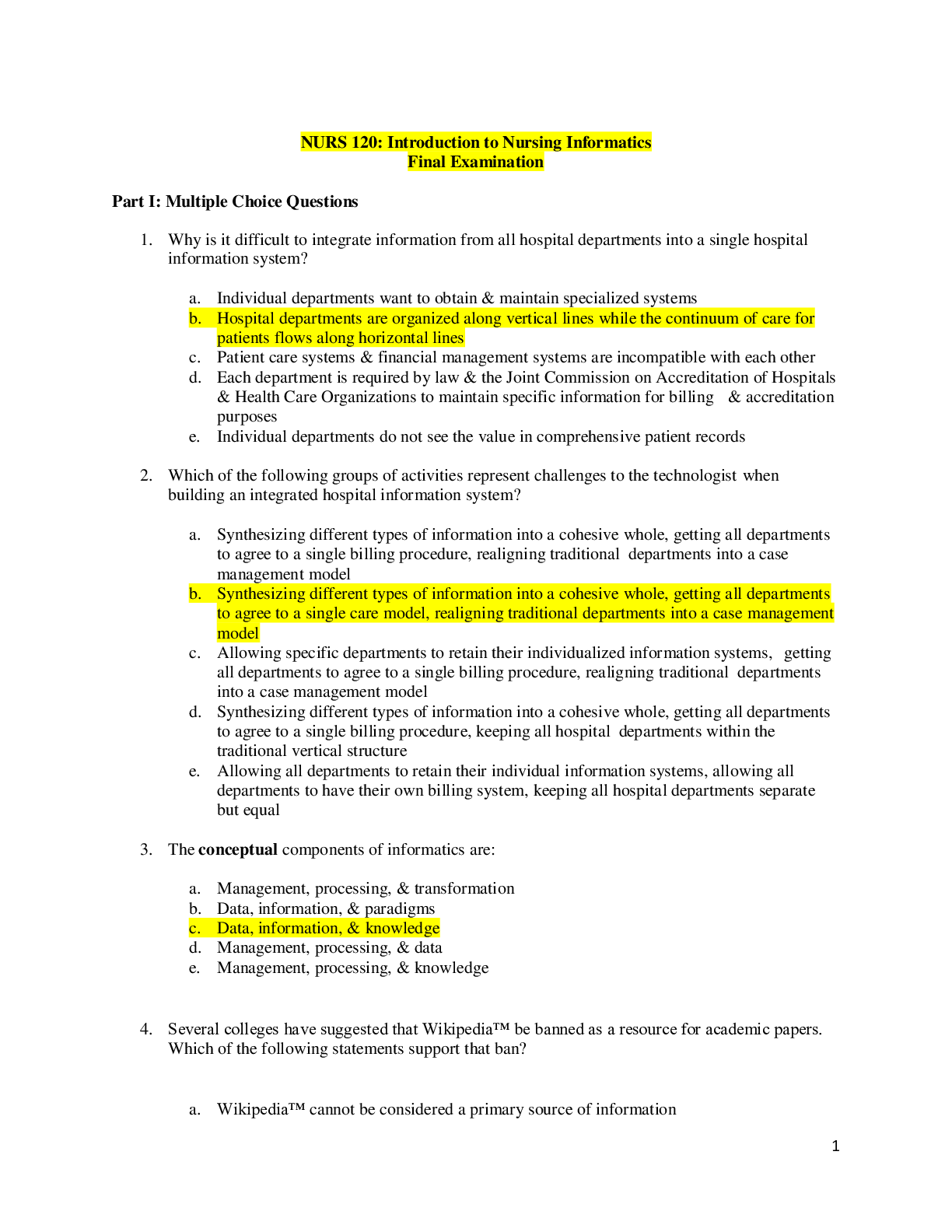
NURS 120 Introduction to Nursing Informatics Final Examination. 80 Questions and Answers.
NURS 120: Introduction to Nursing Informatics Final Examination Why is it difficult to integrate information from all hospital departments into a single hospital information system? a. Individual...
By succeeded , Uploaded: Sep 08, 2020
$10
Document information
Connected school, study & course
About the document
Uploaded On
Jul 31, 2020
Number of pages
64
Written in
Additional information
This document has been written for:
Uploaded
Jul 31, 2020
Downloads
0
Views
293






